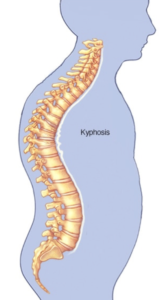Kyphosis
What is Kyphosis?
 Kyphosis refers to an abnormal curvature of the upper spine that causes a rounded or hunched posture.
Kyphosis refers to an abnormal curvature of the upper spine that causes a rounded or hunched posture.
This condition can range from mild to severe, affecting people of all ages. It often leads to postural changes, discomfort, and potential complications if left untreated.
Importance of understanding this condition
Recognizing and comprehending this condition proves vital to ensuring early detection and appropriate intervention. By increasing awareness about this condition, individuals and healthcare professionals can take the necessary measures to prevent further progression and mitigate associated symptoms.
This condition can manifest in various forms, with three common types deserving attention: congenital kyphosis, postural kyphosis, and Scheuermann’s kyphosis. Each type has distinct causes and characteristics, contributing to the overall understanding of this condition.
Causes and Risk Factors of Kyphosis
Congenital kyphosis
Congenital kyphosis is a variation of this condition that occurs during fetal development. Typically, deems present at birth and is caused by anomalies in the spine’s formation, such as malformed vertebrae or fused spinal segments.
Causes and development during fetal growth
The exact causes of congenital kyphosis are not always clear. However, factors like genetic predisposition, maternal smoking, and certain medications can influence its development during pregnancy.
Postural kyphosis
Postural kyphosis is primarily caused by poor posture and habits that place excessive strain on the spine. Slouching, carrying heavy backpacks, and prolonged sitting with a rounded back are common factors contributing to postural kyphosis. Risk factors include sedentary lifestyles, lack of physical activity, and occupations that require prolonged sitting or standing in unfavorable positions. Poor ergonomics and inadequate back support can also contribute to its development.
Overview of Scheuermann’s disease and its impact on kyphosis
Scheuermann’s kyphosis is a structural deformity of the spine that primarily affects adolescents during their growth spurt. It is characterized by wedging of the vertebrae, leading to an exaggerated kyphotic curve. The exact causes are not fully understood, but factors such as genetics, imbalanced growth, and abnormal vertebral bone development are believed to play a role.
Symptoms and Diagnosis
Visible signs and postural changes
Moreover, this condition can result in a visibly rounded upper back, protruding shoulder blades, and a forward head posture. Individuals may also experience muscle fatigue, stiffness, and limited spinal mobility.
Potential pain and discomfort associated with kyphosis
In some cases, this condition can cause pain and discomfort, especially when the curvature is severe. This pain may radiate to the neck, shoulders, and lower back, affecting an individual’s overall quality of life.
Diagnostic Procedures for Kyphosis
Clinical examination and patient history
To diagnose kyphosis, healthcare professionals perform a thorough physical examination, evaluating the patient’s posture, range of motion, and signs of spinal deformity. A detailed patient history is also important to understand potential underlying causes and associated symptoms.
Radiological imaging techniques used to diagnose kyphosis
X-rays, magnetic resonance imaging (MRI), and computed tomography (CT) scans are commonly employed to assess the severity and anatomical details of kyphosis. These imaging techniques help healthcare professionals determine the appropriate treatment approach.
Non-Surgical Treatment Options
Postural exercises and physical therapy
Postural exercises and physical therapy play a crucial role in managing and improving mild to moderate cases of kyphosis. Strengthening the core and back muscles, improving flexibility, and correcting posture are key components of non-surgical treatment.
Orthotic devices and braces to support the spine
In certain instances, orthotic devices such as braces may be recommended to provide external support and prevent further progression of kyphosis. These braces are custom-made to fit the individual’s specific needs and can help improve posture and reduce discomfort.
Surgical Intervention
Indications for surgery in severe cases of kyphosis
Surgery is typically considered when this condition causes significant pain, progressive deformity, or poses a risk to vital organs. Severe cases that do not respond to conservative treatment may require surgical intervention to realign and stabilize the spine.
Description of common surgical procedures and their goals
Various surgical procedures can be performed to treat kyphosis, including spinal fusion, osteotomy (bone reshaping), and vertebral column resection. The goals of surgery are to correct the spinal deformity, relieve pain, and restore functional mobility.
Long-Term Management and Lifestyle Adjustments
Importance of maintaining good posture and ergonomics
Maintaining good posture and practicing proper ergonomics are essential for long-term management of kyphosis. This includes avoiding prolonged sitting or standing in unfavorable positions, using ergonomic furniture, and practicing back-strengthening exercises regularly.
Preventive measures to minimize the risk of kyphosis progression
Prevention plays a crucial role in minimizing the risk of the condition’ progression. Engaging in regular physical activity, maintaining a healthy weight, and adopting correct posture habits from an early age are important preventive measures.
In conclusion, this condition is a spinal condition that demands attention and understanding. By recognizing its causes, symptoms, and treatment options, individuals can take proactive steps to address this condition and prevent its progression.
Early detection, proper diagnosis, and a multidisciplinary approach involving healthcare professionals can greatly improve the quality of life for individuals living with kyphosis. Remember, seeking professional advice is crucial for accurate diagnosis and personalized treatment plans.

